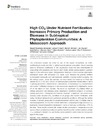Please use this identifier to cite or link to this item:
https://accedacris.ulpgc.es/jspui/handle/10553/41908
| Title: | High CO2 under nutrient fertilization increases primary production and biomass in subtropical phytoplankton communities: A mesocosm approach | Authors: | Hernández-Hernández, Nauzet Bach, Lennart T. Montero, María F. Taucher, Jan Baños, Isabel Guan, Wanchun Espósito, Mario Ludwig, Andrea Achterberg, Eric P. Riebesell, Ulf Arístegui, Javier |
UNESCO Clasification: | 251001 Oceanografía biológica | Keywords: | Ocean acidification Nutrient fertilization Mesocosm Size-fractionated primary production Phytoplankton community structure, et al |
Issue Date: | 2018 | Journal: | Frontiers in Marine Science | Abstract: | The subtropical oceans are home to one of the largest ecosystems on Earth, contributing to nearly one third of global oceanic primary production. Ocean warming leads to enhanced stratification in the oligotrophic ocean but also intensification in cross-shore wind gradients and thus in eddy kinetic energy across eastern boundary regions of the subtropical gyres. Phytoplankton thriving in a future warmer oligotrophic subtropical ocean with enhanced CO2levels could therefore be patchily fertilized by increased mesoscale and submesoscale variability inducing nutrient pumping into the surface ocean. Under this premise, we have tested the response of three size classes (0.2-2, 2-20, and > 20 μm) of subtropical phytoplankton communities in terms of primary production, chlorophyll and cell biomass, to increasing CO2concentrations and nutrient fertilization during an in situ mesocosm experiment in oligotrophic waters offof the island of Gran Canaria. We found no significant CO2-related effect on primary production and biomass under oligotrophic conditions (phase I). In contrast, primary production, chlorophyll and biomass displayed a significant and pronounced increase under elevated CO2conditions in all groups after nutrient fertilization, both during the bloom (phase II) and post-bloom (phase III) conditions. Although the relative increase of primary production in picophytoplankton (250%) was 2.5 higher than in microphytoplankton (100%) after nutrient fertilization, comparing the high and low CO2treatments, microphytoplankton dominated in terms of biomass, contributing > 57% to the total. These results contrast with similar studies conducted in temperate and cold waters, where consistently small phytoplankton benefitted after nutrient additions at high CO2, pointing to different CO2-sensitivities across plankton communities and ecosystem types in the ocean. | URI: | https://accedacris.ulpgc.es/handle/10553/41908 | ISSN: | 2296-7745 | DOI: | 10.3389/fmars.2018.00213 | Source: | Frontiers in Marine Science [ISSN 2296-7745], v. 5 (5), article number 213 |
| Appears in Collections: | Artículos |
SCOPUSTM
Citations
20
checked on Jun 8, 2025
WEB OF SCIENCETM
Citations
19
checked on Jun 8, 2025
Page view(s)
127
checked on Jul 27, 2024
Download(s)
152
checked on Jul 27, 2024
Google ScholarTM
Check
Altmetric
Share
Export metadata
Items in accedaCRIS are protected by copyright, with all rights reserved, unless otherwise indicated.
